Granbury High School Recaptures Precision Title at 2019 JROTC National Air Rifle Championship
Posted By admin on March 29, 2019
By Ashley Brugnone

Leading the sporter teams was Nation Ford High School, followed by Santa Fe and Zion Benton High School.
ANNISTON, Ala. – Defending National Champions, the Granbury High School Marine Corps JROTC program athletes, arrived at the 2019 JROTC National Three-Position Championship, March 21-23, ready to reclaim their roles at the top of the podium. That’s exactly what they did, and more, as they brought home not only team awards, but also individual wins in the precision class.
The two-day scholastic competition, held at the Civilian Marksmanship Program’s (CMP) South Competition Center in Alabama, hosts both precision and sporter class high school athletes in the three-position event. Each day consists of a qualifying match, followed by a finals event for the Top 8 highest scoring athletes of the day. Overall winners are determined from scores collected from both days.

Makenzie Sheffield earned first place overall in the precision competition.
Team member Makenzie Sheffield, 18, helped lead the Granbury, Texas, natives by earning first place in the overall precision individual competition, with a score of 1287.2. Sheffield led the precision class both days of the two-day competition after coming out on top of the eight-competitor final held at the conclusion of each day.
Only one-point shy of Sheffield’s overall score was teammate Philip Becker, 17, who accumulated a score of 1286.4 over the course of the weekend. Last year’s National Champion, Taylor Gibson, 18, of North Salem High School’s Army JROTC in Oregon, earned the third place with a score of 1282.7 in the precision match.
With half of its members earning podium spots and the other half (Clarissa Layland and Elizabeth Plecity) landing in the Top 15 overall, Granbury High School took home the overall team competition for the second consecutive year, with a score of 4704-324x.
Earning second was Joshua High School Navy JROTC, also of Texas, with a score of 4672-295x, followed by Granbury Team 2, which earned third with a score of 4635-276x.

Joshua High School members reached a new Navy National Record during their performances.
Joshua High School also set a Navy JROTC National Team record, with their score of 2335-151x. Member Grace Sharp, 17, who finished fifth overall, set a new Navy JROTC National Record for her finals performance on Day 1 of the precision match, with a score of 104.8.

Jaden-Ann Fraser claimed the overall spot in the sporter individual match.
In the sporter event, Jaden-Ann Fraser, 16, of Volunteer High School Navy JROTC in Tennessee, overtook the individual competition by just one point, with a score of 1222.4. Kayla Kalenza, 15, of Nation Ford High School Marine Corps JROTC in South Carolina, followed in second with a score of 1221.2, as Andrew Larson, 18, of Jack C. Hays Red Marine Corps JROTC in Texas, with a score of 1206.9.
Fraser clinched the competition after claiming the Day 1 final and finishing just behind Kalenza in second on Day 2.

Kayla Kalenza finished in second in the sporter match.
Kalenza’s Nation Ford High School team, along with members, Deonte Hayes, Nick Noto and Sarah Leininger, led as the overall sporter team with a score of 4437-155x. Santa Fe Navy JROTC landed in second, with a score of 4377-144x, with Zion Benton Navy JROTC of Illinois earning third.
Placing teams earned monetary awards from the CMP for their outstanding performances – $500 for fifth, $750 for fourth, $1,000 for third, $1,500 for second and $2,000 for first. The Top 5 individuals also earned money for placing in the competition: $100 for fifth, $200 for fourth, $300 for third, $400 for second and $500 for first.
The CMP was proud to exhibit the talent and efforts of each junior participating in the JROTC Air Rifle Championships. Congratulations to all, and we look forward to next year!
For a complete list of results, visit the Competition Tracker page at https://ct.thecmp.org/app/v1/index.php?do=match&task=edit&tab=results&match=18093. Photos from the event, available for free download and for purchase, can be viewed at https://cmp1.zenfolio.com/f546434324.

Defending champions, Granbury High School, reclaimed their title in 2019.
About the JROTC National Air Rifle Championship:
The road to the JROTC National Championship begins with the JROTC Postal Competition in October, with qualifying teams and individuals moving on to the Regional Service Championships in February at Camp Perry, Ohio; Anniston, Ala.; and a western location.
The National Championship is a two-day competition that follows the same format as the Postal and Regional matches, where competitors fire in three positions – prone, standing and kneeling. During Nationals only, the Top 8 competitors of the day from the precision class and the Top 8 from the sporter class then compete in a 10-shot final, vying for daily gold, silver and bronze medals.
Aggregate scores of each athlete from each day of competition (plus finals) are then combined to determine the overall best junior marksmen in the country amongst all four military branches.
For more information on the JROTC Championships, visit http://thecmp.org/air/jrotc-air-rifle-national-championship/.
The Civilian Marksmanship Program is a federally chartered 501 (c) (3) non-profit corporation. It is dedicated to firearm safety and marksmanship training and to the promotion of marksmanship competition for citizens of the United States. For more information about the CMP and its programs, log onto www.TheCMP.org.

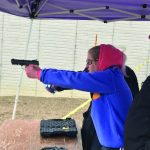


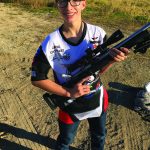
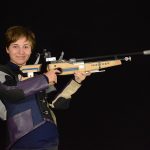


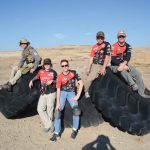



 Though rodeo kids rope and ride, youth rodeo kids now have a chance to shoot competitively as well. Beginning in 2005, the National High School Rodeo Association and the Junior High Division began a shooting program in partnership with the NRA, consisting of small-bore and trap. Now, hundreds of qualifiers from around the nation compete in the junior high and the high school rodeos in small-bore and trap. The competition has grown locally as well. In the last year, the number of competitors in Colorado has nearly doubled. So far, a majority of the states have picked it up and it has taken off to become a major competitive event. Because shooting is such a large part of the cowboy lifestyle, the shoots are very popular.
Though rodeo kids rope and ride, youth rodeo kids now have a chance to shoot competitively as well. Beginning in 2005, the National High School Rodeo Association and the Junior High Division began a shooting program in partnership with the NRA, consisting of small-bore and trap. Now, hundreds of qualifiers from around the nation compete in the junior high and the high school rodeos in small-bore and trap. The competition has grown locally as well. In the last year, the number of competitors in Colorado has nearly doubled. So far, a majority of the states have picked it up and it has taken off to become a major competitive event. Because shooting is such a large part of the cowboy lifestyle, the shoots are very popular.


 Discipline – that is what Jackovich asserts is the biggest thing he has learned from marksmanship, as well as attention to detail. He began to realize that even small factors had an influence on his shooting and when he understood this and learned how to minimize things that would cause a bad shot, he began to excel.
Discipline – that is what Jackovich asserts is the biggest thing he has learned from marksmanship, as well as attention to detail. He began to realize that even small factors had an influence on his shooting and when he understood this and learned how to minimize things that would cause a bad shot, he began to excel.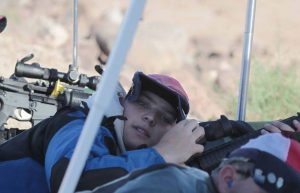





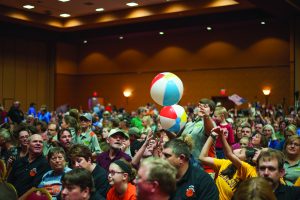






 Shooting, for me, has been the single best instructor in self-sufficiency. My friends and family would describe me as a very independent person; I have to be. Since the age of 13, I’ve had to board airplanes with my gear and guns and take long flights to Colorado Springs, where I get picked up at the airport and taken to the Olympic Training Center. There’s no one there to make sure I eat enough protein before I shoot or keep track of me and make sure I get on the firing line on time. I have to be able to manage my time, and myself, if I want to be successful.
Shooting, for me, has been the single best instructor in self-sufficiency. My friends and family would describe me as a very independent person; I have to be. Since the age of 13, I’ve had to board airplanes with my gear and guns and take long flights to Colorado Springs, where I get picked up at the airport and taken to the Olympic Training Center. There’s no one there to make sure I eat enough protein before I shoot or keep track of me and make sure I get on the firing line on time. I have to be able to manage my time, and myself, if I want to be successful. 




 My first impression was how big the barrel was. Unlike most rimfire shooters, I prefer a heavy barrel for stability, but this gun looked just a bit excessive. But, after picking it up, my thoughts changed gears. Yes, it is heavy, but balanced too. So, the heft isn’t as noticeable as it would appear to be. The barrel is six
My first impression was how big the barrel was. Unlike most rimfire shooters, I prefer a heavy barrel for stability, but this gun looked just a bit excessive. But, after picking it up, my thoughts changed gears. Yes, it is heavy, but balanced too. So, the heft isn’t as noticeable as it would appear to be. The barrel is six 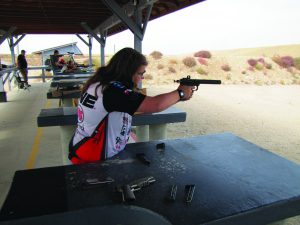




 I have always had a nostalgic feeling for the M1 Carbine (United States Carbine, Caliber .30, M1). A standard firearm for the U.S. Military during World War II, the Korean War, and well into the Vietnam War, its appeal to the civilian market for collectors is huge. The M1 Carbine is a semi-automatic firearm while the M2/M3 are selective fire. However, it is the M1 Carbine that is readily available and a lot of fun to shoot. New replicas from Inland Manufacturing are usually priced a little lower than originals. We tested one last year and were very impressed with it.
I have always had a nostalgic feeling for the M1 Carbine (United States Carbine, Caliber .30, M1). A standard firearm for the U.S. Military during World War II, the Korean War, and well into the Vietnam War, its appeal to the civilian market for collectors is huge. The M1 Carbine is a semi-automatic firearm while the M2/M3 are selective fire. However, it is the M1 Carbine that is readily available and a lot of fun to shoot. New replicas from Inland Manufacturing are usually priced a little lower than originals. We tested one last year and were very impressed with it.
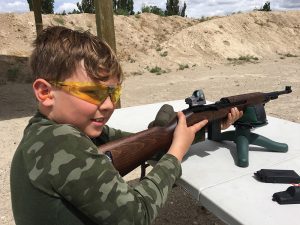



 Juniors Get Safety!
Juniors Get Safety!



 Two dozen youth shooting teams and over 280 athletes from across the state converged on Ellis County Sportsman’s Club in Waxahachie, TX May 5-7 for the Scholastic Clay Target Program’s annual state shotgun championships. “Ellis County is one of the few venues around that can handle a tournament this size in a single weekend,” noted Coach Rich Keele. “If the participation continues growing at this rate, we may have to look at other options.” In fact, SCTP has already reserved a date for next year’s regional tournament to be held at the National Shooting Complex in San Antonio.
Two dozen youth shooting teams and over 280 athletes from across the state converged on Ellis County Sportsman’s Club in Waxahachie, TX May 5-7 for the Scholastic Clay Target Program’s annual state shotgun championships. “Ellis County is one of the few venues around that can handle a tournament this size in a single weekend,” noted Coach Rich Keele. “If the participation continues growing at this rate, we may have to look at other options.” In fact, SCTP has already reserved a date for next year’s regional tournament to be held at the National Shooting Complex in San Antonio.








